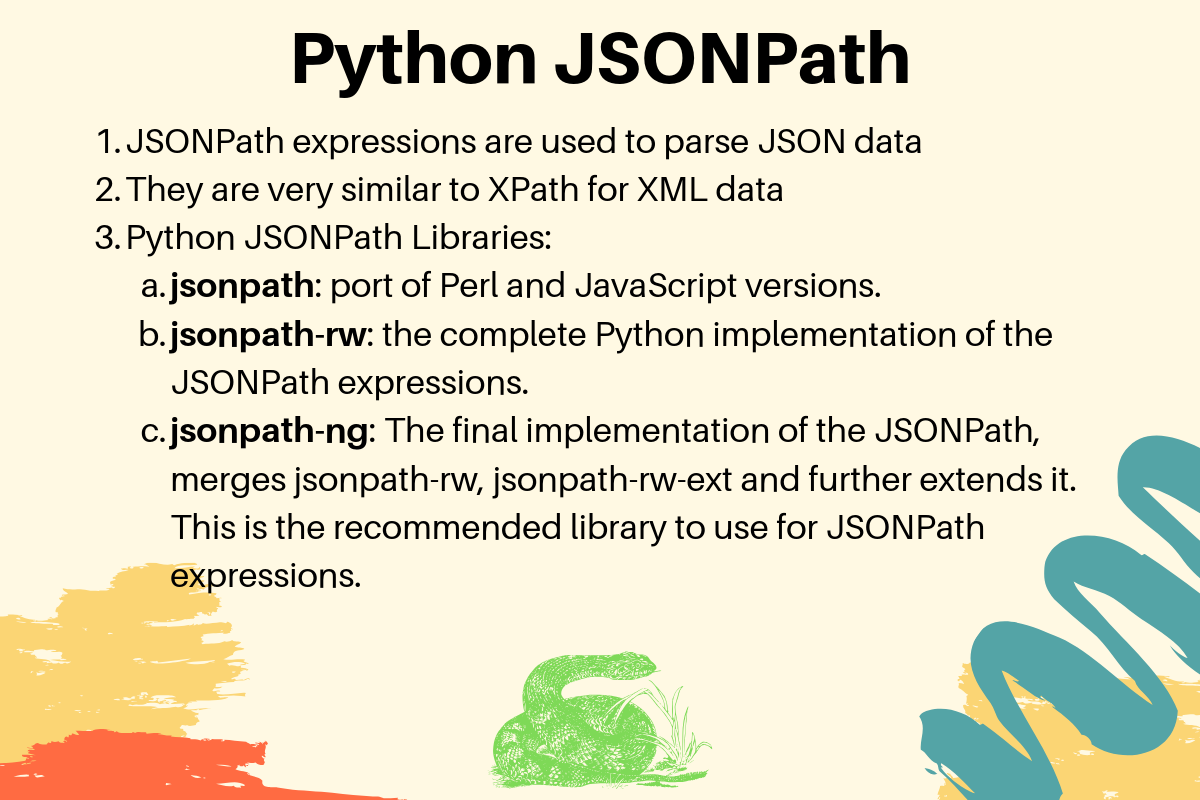- Log in to:
- Community
- DigitalOcean
- Sign up for:
- Community
- DigitalOcean

What is JSONPath?
JSONPath is an expression language to parse JSON data. It’s very similar to the XPath expression language to parse XML data. The idea is to parse the JSON data and get the value you want. This is more memory efficient because we don’t need to read the complete JSON data.
Python JSONPath Libraries
There are many JSONPath libraries in Python.
- jsonpath: It’s a port of the Perl, and JavaScript versions of JSONPath.
- jsonpath-rw: The complete Python implementation of the JSONPath expressions. The JSONPath expressions are first class objects, easy to analyze, transform, parse, print, and extend. The jsonpath-rw-ext module provides some additional extensions to extend its functionalities.
- jsonpath-ng: The final implementation of the JSONPath that aims to be standard compliant, including arithmetic and binary comparison operators. This library merges jsonpath-rw and jsonpath-rw-ext modules and further enhances it.
Which Python JSONPath Library to Use?
The jsonpath-ng module is the most comprehensive and written purely in Python. It supports both Python 2 and Python 3. So, we will use this module for Python JSONPath examples.
Installing jsonpath-ng Module
We can install jsonpath-ng module using PIP.
$ pip3.7 install jsonpath-ng

Parsing a Simple JSON Data using JSONPath
Let’s look at a simple example to parse the JSON data and get the required attribute value.
import json
from jsonpath_ng import jsonpath, parse
json_string = '{"id":1, "name":"Pankaj"}'
json_data = json.loads(json_string)
jsonpath_expression = parse('$.id')
match = jsonpath_expression.find(json_data)
print(match)
print("id value is", match[0].value)
Output:
[DatumInContext(value=1, path=Fields('id'), context=DatumInContext(value={'id': 1, 'name': 'Pankaj'}, path=Root(), context=None))]
id value is 1
We are using json module to convert the JSON string to a dictionary.
Parsing a List using JSONPath Expression
The JSON key can contain a list of values. We can use JSONPath expression to parse the list and get the list of values. Let’s say we have a JSON file “db.json” with the following contents.
{
"employees": [
{
"id": 1,
"name": "Pankaj",
"salary": "10000"
},
{
"name": "David",
"salary": "5000",
"id": 2
}
]
}
We want to parse this JSON file and get the list of employee ids. We can use JSONPath expressions to get this data very easily.
import json
from jsonpath_ng import jsonpath, parse
with open("db.json", 'r') as json_file:
json_data = json.load(json_file)
print(json_data)
jsonpath_expression = parse('employees[*].id')
for match in jsonpath_expression.find(json_data):
print(f'Employee id: {match.value}')
Output:
{'employees': [{'id': 1, 'name': 'Pankaj', 'salary': '10000'}, {'name': 'David', 'salary': '5000', 'id': 2}]}
Employee id: 1
Employee id: 2
Recommended Read: Python f-strings – PEP 498 – Literal String Interpolation
If you want to get the data into a list, you can use Python list comprehension.
emp_ids_list = [match.value for match in jsonpath_expression.find(json_data)]
print(emp_ids_list) # [1, 2]
Conclusion
JSONPath provides us an easy way to parse the JSON data and extract specific values. It’s very useful when the JSON data is huge and we are interested in only few of the values.
References
- jsonpath.com: to test the JSONPath expression validity
- jsonlint.com: to validate JSON data
Thanks for learning with the DigitalOcean Community. Check out our offerings for compute, storage, networking, and managed databases.
About the author
Java and Python Developer for 20+ years, Open Source Enthusiast, Founder of https://www.askpython.com/, https://www.linuxfordevices.com/, and JournalDev.com (acquired by DigitalOcean). Passionate about writing technical articles and sharing knowledge with others. Love Java, Python, Unix and related technologies. Follow my X @PankajWebDev
Still looking for an answer?
What if I only want to read info for employee 1, not for employee 2?
- Jie Liu
Hi Pankaj, Thanks for your nice introductory tutorial on search/parsing a json object. How would you go about extracting a specific set of k, v pair, - given the key. Note that there will be multiple occurrences of the key, with different values. For example, I want to extract all the ‘Statement: ’ in this roles.json (https://github.com/HumanCellAtlas/data-store/blob/a35044e5002b3d05a729702f08ccafeb9aaf1a5f/roles.json). a = datums = parse(’$…Statement’).find(a) len(datums) = 5. ===> this is not what I want. In fact, there are many more statements in roles.json Your help is very much appreciated.
- Sri
Hi Pankaj, Given the JSON structure as below is there a way using Python we can find if a given node has child nodes or not { “class”: { “student”: { “name”: “James”, “marks”: { “physics”: 70, “chemistry”: 73, “mathematics”: 80 } } } }
- Shubhojit
- Table of contents
- What is JSONPath?
- Python JSONPath Libraries
- Which Python JSONPath Library to Use?
- Installing jsonpath-ng Module
- Parsing a Simple JSON Data using JSONPath
- Parsing a List using JSONPath Expression
- Conclusion
- References
Deploy on DigitalOcean
Click below to sign up for DigitalOcean's virtual machines, Databases, and AIML products.
Become a contributor for community
Get paid to write technical tutorials and select a tech-focused charity to receive a matching donation.
DigitalOcean Documentation
Full documentation for every DigitalOcean product.
Resources for startups and SMBs
The Wave has everything you need to know about building a business, from raising funding to marketing your product.
Get our newsletter
Stay up to date by signing up for DigitalOcean’s Infrastructure as a Newsletter.
New accounts only. By submitting your email you agree to our Privacy Policy
The developer cloud
Scale up as you grow — whether you're running one virtual machine or ten thousand.
Get started for free
Sign up and get $200 in credit for your first 60 days with DigitalOcean.*
*This promotional offer applies to new accounts only.
